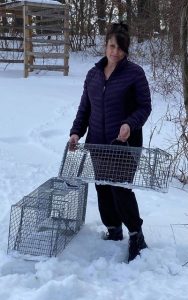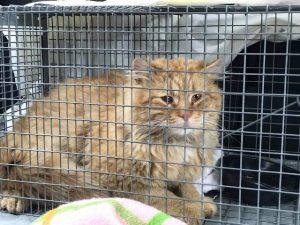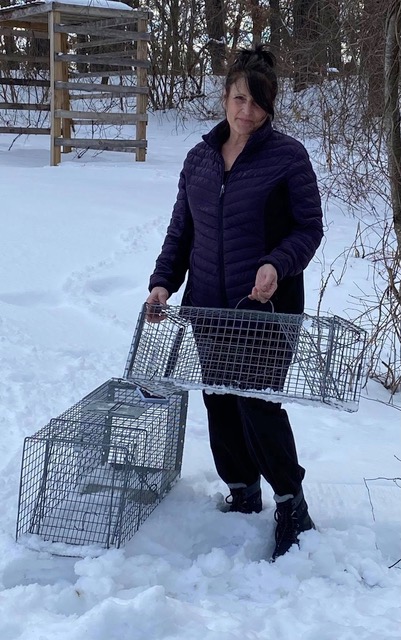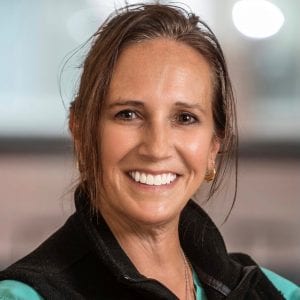GREATER WESTFIELD-With “hundreds” of feral cat colonies in Westfield alone, local trappers including Julia Toomey of Feeding Hills are always on the front lines to help control the population which can escalate if not kept in check.
“I first worked with the original Homeless Cat Project and then started working with Denise Sinico of the Westfield Homeless Cat Project,” said Toomey, who has spent countless volunteer hours since 1998 to try and help stabilize the cat population.
“I’ve been involved in animal rescue for over 35 years starting at about the age of 18 or 19,” said Toomey. “It all started when I rescued my first cat from the rafters of an auto dealership building.”

Julia Toomey has worked with rescue groups over the years to trap feral cats that can then be spayed or neutered and then returned to their colony. (SUBMITTED PHOTO)
Toomey said from that moment in time to dealing with neighbors who were abusive and neglectful with their animals, she felt led to follow an “aggressive path” of learning how to deal with the situations she was witnessing.
“I learned a lot and my compassion for animals grew deeper,” she said, adding, “I began to do any kind of rescue that I could find.”
Over the years, Toomey did volunteer work with the MSPCA in Springfield, as well as the private dog rescue group F.A.C.E.S. in West Springfield.
“I also got involved with rescuing wildlife and worked with a rehabber out of Connecticut as a volunteer,” she said, adding, “I learned quite a bit while working with her.”
Her path has also included rescuing stray dogs, cats, birds and “any other creatures” that were in distress.
“By now I was addicted and that’s when I met Debbie LaBruzzo back in the 90’s,” said Toomey. “Debbie was a pioneer in animal rescue; she was an amazing woman and eventually became my mentor.”
Toomey said she learned about the overwhelming cat population and the suffering of feral cats.
“Debbie explained she was involved in a new program at the time called TNR (trap, neuter and return) of feral cats that would help combat this astronomical problem,” said Toomey.
Toomey explained that a “colony” typically has at least five cats or more.
“Female cats can have four litters a year and each litter can go up to eight kittens,” said Toomey, adding, “A kitten can get pregnant at four to five months so they breed like rabbits do.”
Toomey noted that every community has a feral cat situation and it is “out of control.”
“Wherever you live it is out of control,” said Toomey, noting “cats are good hiders.”
Once Toomey traps a feral cat, the feline is taken to a participating clinic where the surgeries are performed at low cost or might also be covered by grants.
“The cats are tested for diseases, are flea treated, vaccinated, treated for parasites and any other issues that they may have,” said Toomey. “They recuperate overnight or for one or two days and then we pick them up and release them where we found them mainly because feral cats are un-adoptable because they are wild.”
Toomey noted, however, that kittens can be “easily domesticated” if they are caught before four months of age.
“After four months, kittens become too feral and they have to go back,” she said. “There is always hope though that some cats and kittens are more responsive to being domesticated than others.”
Toomey is quick to acknowledge the volunteers who feed the colonies and make cold weather shelters for them.
“They are very dedicated to caring for these colonies and trust me, it’s a lot of work and it’s not cheap,” she said.
While Toomey considers herself “sort of retired” from the volunteer role, she said, “you can never say no when asked.”
“I have slowed down a bit but when emergency situations involving a pregnant mom and kittens are involved, especially outside, I will trap them and bring them to the Westfield Homeless Cat Project,” she said. “I know that Denise will have someone who can foster the mom until she has the kittens.”
For anyone considering becoming a trapper, Toomey said the role “takes a lot of planning, time and patience.”
“One of the most difficult parts of being a trapper out in the field almost every day is that we often see horrific things that you can never un-see again,” she said. “Not only are we physically exhausted, but it’s emotionally draining for all people involved in rescue, not just trappers.”
Toomey added that trapping is not for everyone.
“Most people think we just put a trap down and wait for a cat to go in it but’s much more than that,” she said.
For Toomey, the work she has done over the many years has been rewarding.

Our region has several volunteer trappers who work with local shelters to try to keep the cat population in check. (SUBMITTED PHOTO)
“I enjoy this work because it is very rewarding to me to be able to bring some comfort to these unfortunate suffering animals who did not ask to be here,” she said. “It’s very hurtful to me that many irresponsible humans allow this out of control overpopulation of cats to occur.”
Toomey also thanked the many “wonderful people” who step up every day to help the feral colonies.
“There are a lot of wonderful people out there who are extremely generous, compassionate and donate to our cause by making donations and/or volunteering their time at the shelters or even by feeding colonies of cats struggling to survive outside which by the way is a huge commitment,” she said.
Toomey noted that it takes a village of volunteers to lend a hand in helping the feral colonies.
“I often encourage others to get involved with animal rescue because there is a huge need to help whether you are working directly in the field as I do or on the sidelines, these animals desperately need our help,” she said.
On a related note, the state offers a trapper education course that is mandatory in Massachusetts for Problem Animal Control (PAC) agents and first-time trappers who wish to apply for a trap registration number. Using both classroom work and field training, students receive instruction on best management practices for trapping furbearers, the proper use of traps, furbearer identification, trapping laws, ethics, and landowner relations. For more details, call MassWildlife weekdays at (508) 389-6300.








